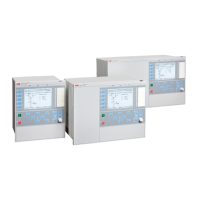4. Overall check in principal as above (non-directional overcurrent feature)
5. Reverse the direction of the injection current and check that the protection does not
trip.
6. Check with low polarization voltage that the feature becomes non-directional,
blocked or with memory according to the setting.
11.8.1.5 Over/Undervoltage feature
Procedure
1. Connect the test set for injection three-phase voltages to the appropriate voltage
terminals of the IED.
2. Inject voltage(s) in a way that relevant measured (according to setting parameter
VoltageInput) voltages are created from the test set.
3. Overall check in principal as above (non-directional overcurrent feature) and
correspondingly for the undervoltage feature.
11.8.1.6 Completing the test
Continue to test another function or end the test by changing the TESTMODE setting to
Disabled. Restore connections and settings to their original values, if they were changed
for testing purposes.
11.9 Secondary system supervision
11.9.1 Current circuit supervision CCSSPVC (87)
Prepare the IED for verification of settings outlined in Section
"Preparing the IED to
verify settings".
The Current circuit supervision function CCSSPVC (87) is conveniently tested with the
same three-phase test set as used when testing the measuring functions in the IED.
The condition for this procedure is that the setting of IMinOp is lower than the setting of
Pickup_Block.
Prepare the IED for verification of settings outlined in Section
"Preparing the IED to
verify settings".
Values of the logical signals for CCSSPVC are available on the local HMI under Main
menu/Tests/Function status/Secondary system supervision/
CurrentCircuitSupervision(87,INd/I)/CCSSPVC(87;INd/I):x, where x = 1, 2 and 3.
1MRK 504 165-UUS - Section 11
Testing functionality by secondary injection
Transformer protection RET670 2.2 ANSI 229
Commissioning manual

